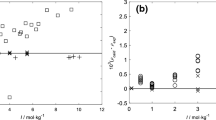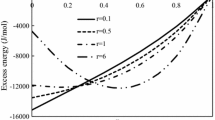Abstract
The new generation geometric model has been proposed to calculate the thermodynamic properties for multi-component systems in terms of the properties of their corresponding binaries, in which the “similarity coefficient” ξ has been introduced based on the “deviation sum of squares”, η 1. This function is the key conception of the new generation geometrical model. A different η function besides “deviation sum of squares” has been mentioned in the previous papers. However, discussion of the effect of η in the prediction is scarce. In this paper the density data of molten NaCl–MgCl2–CaCl2 systems were predicted via three different η parameters. It is found that different kinds of η functions yield different calculation results. The results show that the mean relative errors of three different η parameters were no more than 0.75 %, which is in an acceptable range. Therefore, the two methods proposed in this paper could be used for computing physicochemical properties. Three other η functions were also provided and discussed.



Similar content being viewed by others
References
Chou, K.C.: A general solution model for predicting ternary thermodynamic properties. Calphad 19, 315–325 (1995)
Chou, K.C., Wei, S.K.: A new generation solution model for predicting thermodynamic properties of a multicomponent system from binaries. Metall. Mater. Trans. B 28, 439–445 (1997)
Živković, D., Du, Y., Talijan, N., Kostov, A., Balanović, L.: Calculation of thermodynamic properties in liquid phase for ternary Al–Ni–Zn alloys. Trans. Nonferrous Met. Soc. China 22, 3059–3065 (2012)
Chen, Z., Liu, J., Yu, Z., Chou, K.C.: Electrical conductivity of CaCl2–KCl–NaCl system at 1080 K. Thermochim. Acta 543, 107–112 (2012)
Hindler, M., Mikula, A.: Calorimetric investigations of liquid gold–antimony–tin alloys. Int. J. Mater. Res. 103, 858–865 (2012)
Nikolaev, V., Satgaraev, A., Sultanova, R.: Predicting property isotherms of ternary mixtures on isotherms of the binary mixtures, presented by a non-stoichiometric model. J. Solution Chem. 41, 953–964 (2012)
Zeng, H.H., Xiang, X.Z., Lei, S.M.: Formation enthalpies of yellow gold alloys with re addition calculated with Chou’ models. Adv. Mater. Res. 476, 89–93 (2012)
Chou, K.C., Austin Chang, Y.: A study of ternary geometrical models. Ber Bunsen. Phys. Chem. 93, 735–741 (1989)
Iloukhani, H., Khanlarzadeh, K.: Physicochemical properties of quaternary systems and comparison of different geometrical models. J. Chem. Eng. Data 56, 4244–4252 (2011)
Zhang, G.H., Wang, L.J., Chou, K.C.: A comparison of different geometrical models in calculating physicochemical properties of quaternary systems. Calphad 34, 504–509 (2010)
Kohler, F.: Estimation of the thermodynamic data for a ternary system from the corresponding binary systems. Monatsh. Chem. 91, 738–740 (1960)
Muggianu, Y., Gambino, M., Bros, J.: A new solution model. J. Chim. Phys. 72, 83–88 (1965)
Zhang, G.H., Chou, K.C.: General formalism for new generation geometrical model: application to the thermodynamics of liquid mixtures. J. Solution Chem. 39, 1200–1212 (2010)
Chou, K.C.: New generation solution geometrical model and its further development. Acta Metall. Sinica 33, 126–132 (1997). (in Chinese)
Grjotheim, K., Holm, J., Lillebuen, B., Øye, H.: Densities and excess molar volumes of binary and ternary melts of MgCl2, CaCl2 and AlkCl. Trans. Faraday Soc. 67, 640–648 (1971)
Redlich, O., Kister, A.: Algebraic representation of thermodynamic properties and the classification of solutions. Ind. Eng. Chem. 40, 345–348 (1948)
Janz, G.J., Allen, C.B., Bansal, N., Murphy, R., Tomkins, R.: Physical properties data compilations relevant to energy storage. II. Molten salts: data on single and multi-component salt systems. In: Rensselaer Polytechnic Inst., Cogswell Lab., Troy (1979)
Janz, G.J., Tomkins, R.: Physical properties data compilations relevant to energy storage. IV. In: Molten salts: data on Additional single and multi-component salt systems. National Standard Reference Data System (1981)
Acknowledgments
The authors wish to express thanks to the Chinese National Science Foundation (Grant No. 51174022) and the National Program on Key Basic Research Project of China (Grant No. 2012CB215405) for their kind financial support.
Author information
Authors and Affiliations
Corresponding author
Rights and permissions
About this article
Cite this article
Chen, ZY., Wang, LJ., Chou, KC. et al. Comparison of Different Calculation Methods of the New Generation Geometric Model in Predicting the Density of NaCl–MgCl2–CaCl2 Systems. J Solution Chem 43, 577–584 (2014). https://doi.org/10.1007/s10953-014-0147-6
Received:
Accepted:
Published:
Issue Date:
DOI: https://doi.org/10.1007/s10953-014-0147-6




